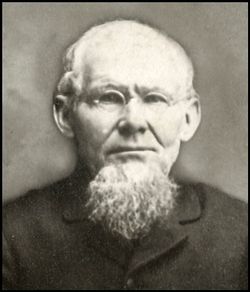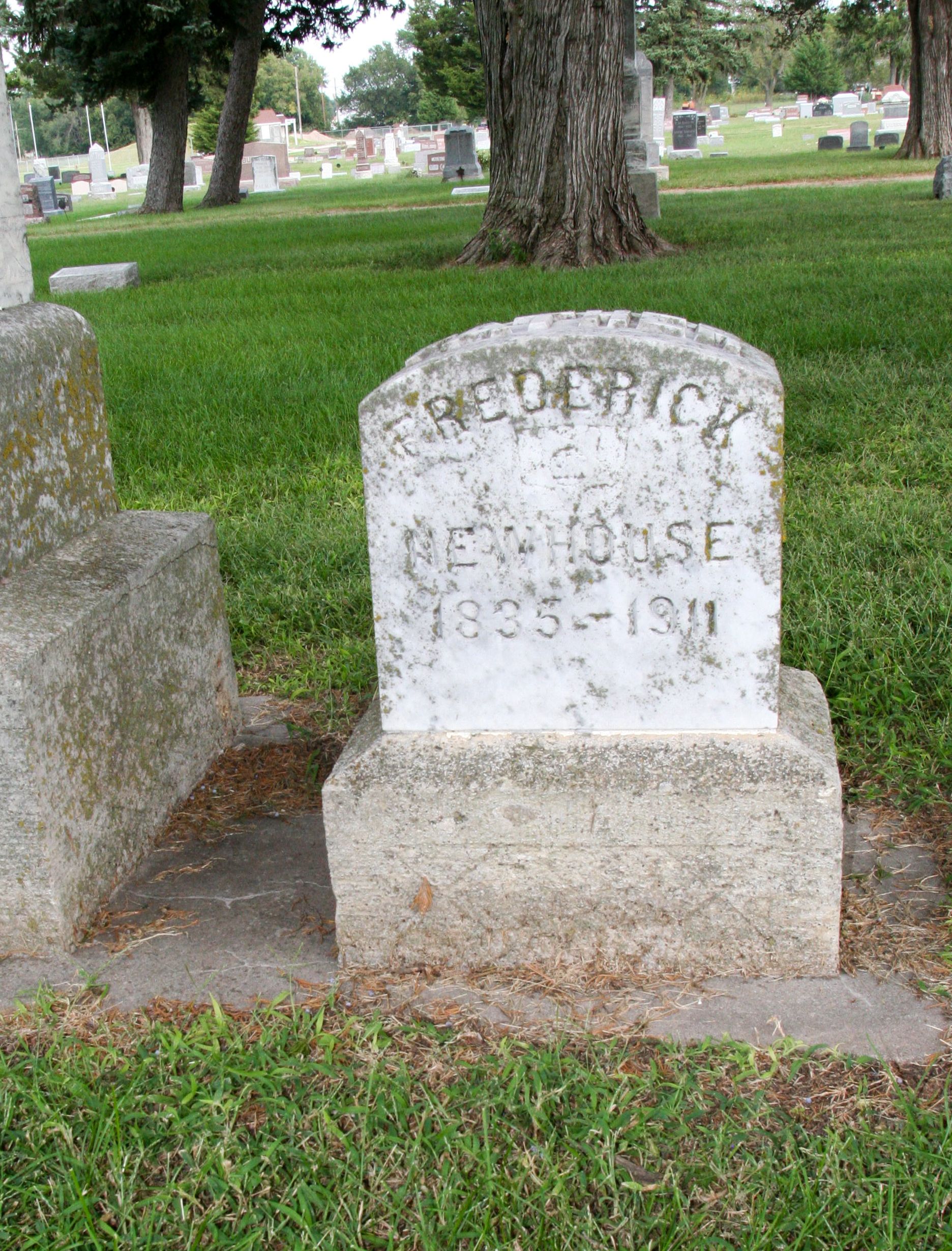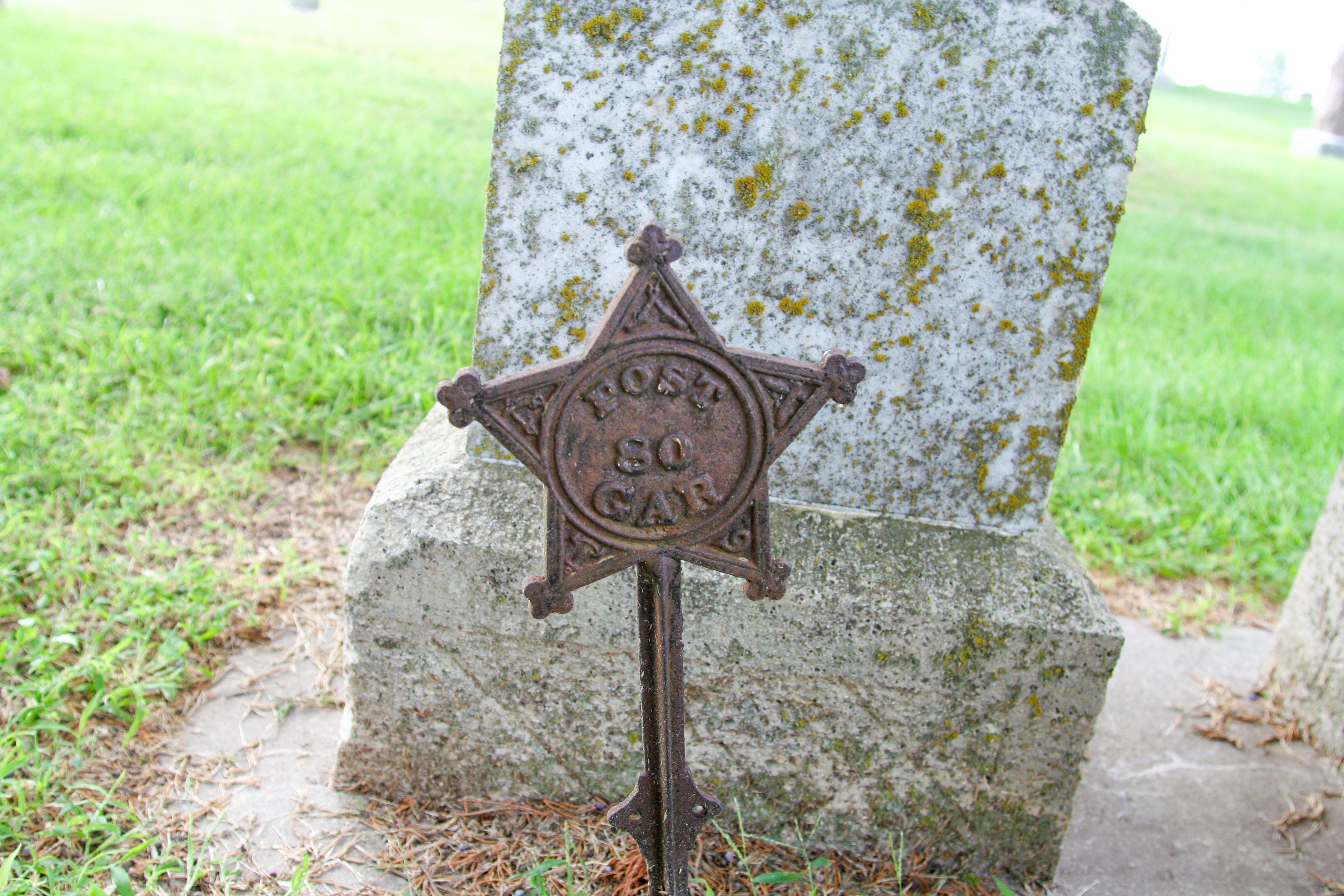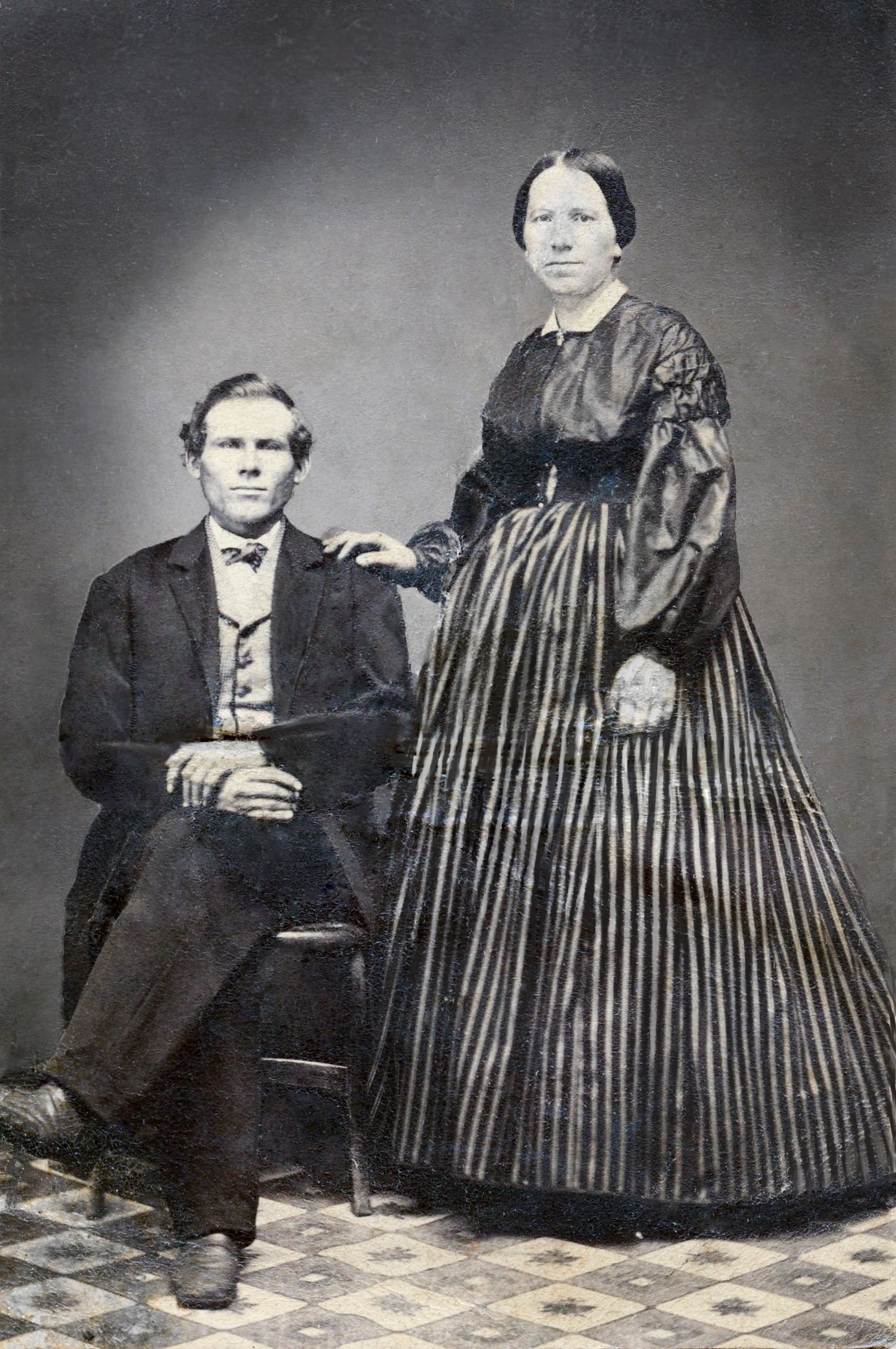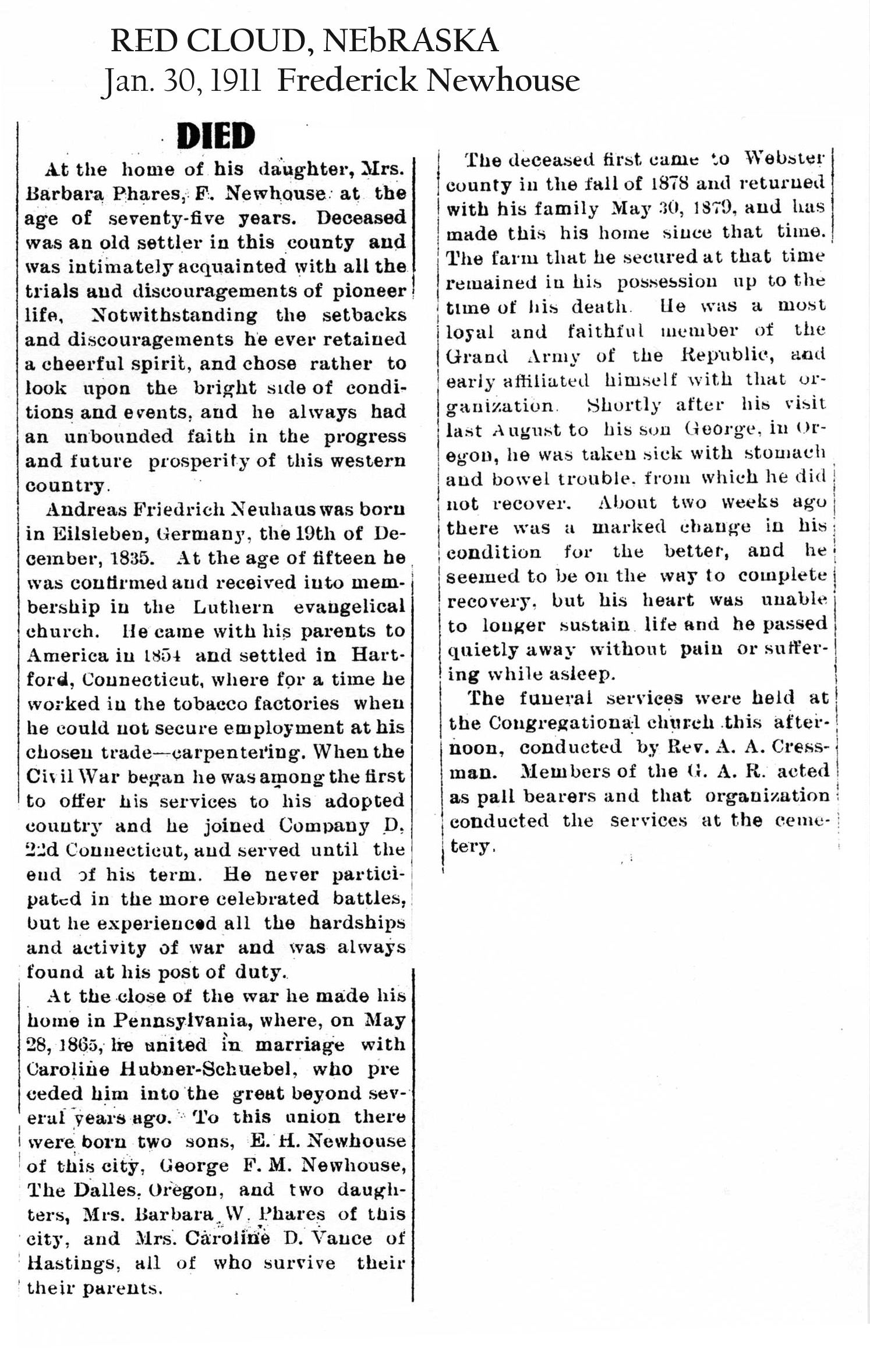B
efore we continue any further with the story of Barbara (Newhouse) Phares, we need to drop back and pick up the story of her parents. Her mother, Caroline (Huebner) Newhouse, has a back story of her own before Frederick Newhouse comes into the picture. Maria Margarita Caroline Huebner was born in Moenchsroth, Bavaria, Germany, near Dinkelsbühl July 18, 1833. She came to America in about 1854 or 1855.
Caroline’s first husband, Heinrich Friedrich “Fritz” Schuebel, was born June 25, 1825 – also in Moenchsroth. It appears that Fritz Schuebel (his name on the passenger list was spelled Heinrich Seibel) arrived in the United States aboard the Alfred on June 1, 1853. Although they apparently knew each other in Germany, Fritz and Caroline did not come at the same time. From old letters, the assumption has been made that Fritz may have had ideas of marrying someone else before he married Caroline. They were married in Mauch Chunk in 1855, and their children were baptized there.
Heinrich Friedrich “Fritz” Schuebel was killed in the last part of 1862 or early part of 1863. It is believed that Caroline and their three children were quarantined for some disease when her husband was killed at work, presumably in a mining accident, and the workers brought his body to the home and laid it on the porch. She had to build the casket by herself. Evidently one of the children died about this same time and undoubtedly was placed in the casket with its father. Another child died not long thereafter as it seems there was only one living child when she married Frederick Newhouse.
Andreas Frederick Newhouse – it was Neuhaus in Germany – came to America aboard the Aristides, arriving in the United States on December 15, 1855, just four days before his twentieth birthday. As the story is told, Frederick was headed out the back door as his mother went to the front door to answer the knock of the German military police. Military conscription was one of the main reasons young men left Germany in the 1800s. Nevertheless, a few short years later he and his brother served in the Union Guard, Company D, 22nd Regiment, Connecticut Volunteer Infantry during the Civil War. Fred’s service record shows he enlisted as a private on August 23, 1862, and was mustered out on July 7, 1863, at Hartford, Connecticut.
Frederick went to work in Mauch Chunk, Pennsylvania, shortly before 1865 – he apparently was a carpenter – where he met the widowed Caroline (Huebner) Schuebel. They were married on May 28, 1865, at St. Paul’s Church, Hartford, Connecticut. They returned to Mauch Chunk, Pennsylvania, where their four children, Lena, Barbara, George, and Henry, were born and christened. Frederick must have also worked in the coal mines for a time. In her book about Nebraska author Willa Cather, a Red Cloud woman by the name of Mildred Bennett wrote:
At first Mr. and Mrs. Newhouse lived in Pennsylvania, where he worked in coal mines; but when he was injured, they started a little store. In 1878 he went west to visit a sister. Knowing him well, his wife said when he left, “Now don’t buy any land.” But when he returned in ’79, he had invested in a farm and soon moved to Nebraska to work it, while his wife opened a small store specializing in yarns and laces. At first their daughter, Barbara, was ill from the change in water and her mother, homesick for Pennsylvania, went east. But when she saw again the black coal pits and realized what future lay in store there for her sons, she returned to Nebraska. Although she never ceased grieving for old friends in the East, she cheerfully went about the task of building a future for her family.
After the family moved to Red Cloud, Fred built a two-story frame building with the first floor to be used as a store, living room and kitchen, with sleeping quarters on the second story. He also purchased a farm four miles north of Red Cloud, but Caroline refused to live on the farm, preferring to live in town, where she ran a dry goods store. Barbara (Newhouse) Phares later recalled that her mother complained that he spent the profits from the store on the farm.
Fred was interested in conservation and rigged up an implement, similar to a duck-foot, to leave pockets in the soil to hold water. From this farm, he brought four small trees and planted them in front of the store to be used as hitching posts for horses. Two trees were barked by the horses being tied to them but the remaining trees, a box elder and cottonwood remained more than fifty years. The box elder tree was removed in the early 1930s and the cottonwood stood until the late 1940s, when it had to be removed. There was at that time, only one other tree in Red Cloud that was older. The following excerpt is from a Red Cloud newspaper:
One by one pioneer landmarks disappear. The large cottonwood tree, which for years has been a haven of shade on the east side of the street in front of the Phares and Newhouse Store building in Red Cloud, is this week being cut down. Decay in the huge trunk is the reason… This old tree was already planted before there were any brick buildings in town, before the railroads were built through here, before the building of the old high school building, before the city street car was in operation…
Among other properties, which Frederick and Caroline purchased as years went by was the one rented to the Cather family where Willa Cather grew up. It would have been purchased before 1884, since that is when the Cathers first rented it from them. In one of her books, Cather mentions the little German landlord coming to collect the rent. Mildred Bennett adds further to what we know about Caroline Newhouse in her book, The World of Willa Cather:
The home in which the Cather family lived in Red Cloud belonged to Mrs. Newhouse, a German woman who had an extremely original way of expressing herself. Her sayings and nicknames for people have found their way into Miss Cather’s writing. Mrs. Newhouse, though she claimed to trace her ancestry to Charlemagne, had no use for so-called high society, and when someone thought himself superior because he lived in the north part of town, she named that section, “Quality Knob.” In Lucy Gayhart, Miss Cather calls it “Quality Street.”
A sister of Mrs. Newhouse had been wet nurse to Kaiser Wilhelm… Her father was a weaver, and she had come to the United States when she was twenty-two. She recognized the greater security of the new country, and as a staunch citizen, she hated for anyone to say the old country was better. When after thirty-five years some of her relatives came to see her, she was happy, but whenever her nephew complained, “Auntie, we don’t do like that in Germany,” she would reply in good spirit, “August, if you think Germany is so good, why don’t you go back. Nobody asked you to come here.” She was of that sturdy stock who came to America planning to find it better and meaning to make it better.
Caroline (Huebner) Newhouse died on January 23, 1902, and Frederick Newhouse died on January 30, 1911. They are buried in the Red Cloud Cemetery.
Contributor: Nelson~Phares (49261234)
B
efore we continue any further with the story of Barbara (Newhouse) Phares, we need to drop back and pick up the story of her parents. Her mother, Caroline (Huebner) Newhouse, has a back story of her own before Frederick Newhouse comes into the picture. Maria Margarita Caroline Huebner was born in Moenchsroth, Bavaria, Germany, near Dinkelsbühl July 18, 1833. She came to America in about 1854 or 1855.
Caroline’s first husband, Heinrich Friedrich “Fritz” Schuebel, was born June 25, 1825 – also in Moenchsroth. It appears that Fritz Schuebel (his name on the passenger list was spelled Heinrich Seibel) arrived in the United States aboard the Alfred on June 1, 1853. Although they apparently knew each other in Germany, Fritz and Caroline did not come at the same time. From old letters, the assumption has been made that Fritz may have had ideas of marrying someone else before he married Caroline. They were married in Mauch Chunk in 1855, and their children were baptized there.
Heinrich Friedrich “Fritz” Schuebel was killed in the last part of 1862 or early part of 1863. It is believed that Caroline and their three children were quarantined for some disease when her husband was killed at work, presumably in a mining accident, and the workers brought his body to the home and laid it on the porch. She had to build the casket by herself. Evidently one of the children died about this same time and undoubtedly was placed in the casket with its father. Another child died not long thereafter as it seems there was only one living child when she married Frederick Newhouse.
Andreas Frederick Newhouse – it was Neuhaus in Germany – came to America aboard the Aristides, arriving in the United States on December 15, 1855, just four days before his twentieth birthday. As the story is told, Frederick was headed out the back door as his mother went to the front door to answer the knock of the German military police. Military conscription was one of the main reasons young men left Germany in the 1800s. Nevertheless, a few short years later he and his brother served in the Union Guard, Company D, 22nd Regiment, Connecticut Volunteer Infantry during the Civil War. Fred’s service record shows he enlisted as a private on August 23, 1862, and was mustered out on July 7, 1863, at Hartford, Connecticut.
Frederick went to work in Mauch Chunk, Pennsylvania, shortly before 1865 – he apparently was a carpenter – where he met the widowed Caroline (Huebner) Schuebel. They were married on May 28, 1865, at St. Paul’s Church, Hartford, Connecticut. They returned to Mauch Chunk, Pennsylvania, where their four children, Lena, Barbara, George, and Henry, were born and christened. Frederick must have also worked in the coal mines for a time. In her book about Nebraska author Willa Cather, a Red Cloud woman by the name of Mildred Bennett wrote:
At first Mr. and Mrs. Newhouse lived in Pennsylvania, where he worked in coal mines; but when he was injured, they started a little store. In 1878 he went west to visit a sister. Knowing him well, his wife said when he left, “Now don’t buy any land.” But when he returned in ’79, he had invested in a farm and soon moved to Nebraska to work it, while his wife opened a small store specializing in yarns and laces. At first their daughter, Barbara, was ill from the change in water and her mother, homesick for Pennsylvania, went east. But when she saw again the black coal pits and realized what future lay in store there for her sons, she returned to Nebraska. Although she never ceased grieving for old friends in the East, she cheerfully went about the task of building a future for her family.
After the family moved to Red Cloud, Fred built a two-story frame building with the first floor to be used as a store, living room and kitchen, with sleeping quarters on the second story. He also purchased a farm four miles north of Red Cloud, but Caroline refused to live on the farm, preferring to live in town, where she ran a dry goods store. Barbara (Newhouse) Phares later recalled that her mother complained that he spent the profits from the store on the farm.
Fred was interested in conservation and rigged up an implement, similar to a duck-foot, to leave pockets in the soil to hold water. From this farm, he brought four small trees and planted them in front of the store to be used as hitching posts for horses. Two trees were barked by the horses being tied to them but the remaining trees, a box elder and cottonwood remained more than fifty years. The box elder tree was removed in the early 1930s and the cottonwood stood until the late 1940s, when it had to be removed. There was at that time, only one other tree in Red Cloud that was older. The following excerpt is from a Red Cloud newspaper:
One by one pioneer landmarks disappear. The large cottonwood tree, which for years has been a haven of shade on the east side of the street in front of the Phares and Newhouse Store building in Red Cloud, is this week being cut down. Decay in the huge trunk is the reason… This old tree was already planted before there were any brick buildings in town, before the railroads were built through here, before the building of the old high school building, before the city street car was in operation…
Among other properties, which Frederick and Caroline purchased as years went by was the one rented to the Cather family where Willa Cather grew up. It would have been purchased before 1884, since that is when the Cathers first rented it from them. In one of her books, Cather mentions the little German landlord coming to collect the rent. Mildred Bennett adds further to what we know about Caroline Newhouse in her book, The World of Willa Cather:
The home in which the Cather family lived in Red Cloud belonged to Mrs. Newhouse, a German woman who had an extremely original way of expressing herself. Her sayings and nicknames for people have found their way into Miss Cather’s writing. Mrs. Newhouse, though she claimed to trace her ancestry to Charlemagne, had no use for so-called high society, and when someone thought himself superior because he lived in the north part of town, she named that section, “Quality Knob.” In Lucy Gayhart, Miss Cather calls it “Quality Street.”
A sister of Mrs. Newhouse had been wet nurse to Kaiser Wilhelm… Her father was a weaver, and she had come to the United States when she was twenty-two. She recognized the greater security of the new country, and as a staunch citizen, she hated for anyone to say the old country was better. When after thirty-five years some of her relatives came to see her, she was happy, but whenever her nephew complained, “Auntie, we don’t do like that in Germany,” she would reply in good spirit, “August, if you think Germany is so good, why don’t you go back. Nobody asked you to come here.” She was of that sturdy stock who came to America planning to find it better and meaning to make it better.
Caroline (Huebner) Newhouse died on January 23, 1902, and Frederick Newhouse died on January 30, 1911. They are buried in the Red Cloud Cemetery.
Contributor: Nelson~Phares (49261234)
Inscription
22 CT Infantry Co. D
Family Members
Sponsored by Ancestry
Advertisement
Records on Ancestry
Advertisement
